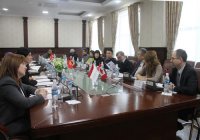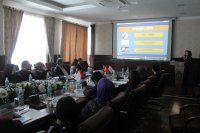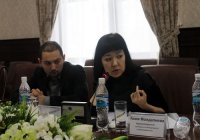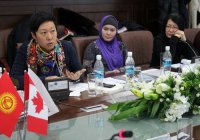16-02-2016, 15:41 Category: English, News
 The public discussion "Hate Speech and Discrimination through the Media. Trends, Influence, Challenges, Countering” was held on February 10, 2016.
The public discussion "Hate Speech and Discrimination through the Media. Trends, Influence, Challenges, Countering” was held on February 10, 2016.
The participants of the event were Shawn Steil, Canada’s Ambassador to Kazakhstan, Kyrgyzstan and Tajikistan, Sanzharbek Tazhimatov, expert of the department of ethnic, religious policies and interaction with civil society of the Presidential Administration of the Kyrgyz Republic, Ablabek Asankanov, head of Monitoring Center of GAMSUMO [State Agency for Local Government Affairs and Ethnic Relations] of the Kyrgyz Republic, representatives of international, civil, religious organizations, and media experts.
The participants discussed the level of hate speech in media and on the internet, the role of new media and social networks in spreading the hate speech, its impact on the audience, dynamics and trends of ethnic, religious and social stereotypes, and also elaborated a number of recommendations on prevention of hate speech.
On the one hand, media monitoring "Hate Speech in Media, Internet and Public Discourse – 2015” carried out by a group of experts of the School of Peacemaking and Media Technologies showed that the main , the main targets of dehumanising metaphors and ad hominem attacks were the Muslims, ethnic groups and LGBT. This was related to the increasing number of Syrian refugees in Europe, facts of recruitment of Kyrgyzstan residents to the ISIL, increased hate in the local society against refugees and foreigners, discussions about the gay propaganda draft law.
Click here for the Summary of study "Hate speech in media, internet and public discourse -2015” and for infographics.

According to monitoring, almost 62% of negative-tone statements were used by the media against ethnic groups. Journalists and users targeted Russians, Chinese, Turks and Canadians in most cases. Often authors of articles and posts confused ethnicity of the main characters with their citizenships. In some cases, it happens when the topic is being politicized; in other cases, it happens due to the failure to meet the text writing standards.
Canada’s ambassador Shawn Steil expressed his surprise at the negative image of Canadians in local media outlets. Although, in many cases stereotypes and clichés against Canadians were reported in articles and posts that discussed the Kumtor gold mining company.
"When we first started supporting the project on hate speech control, we couldn’t even imagine that Canada would become the object of hate speech, which makes the society become a one-dimensional space,” ambassador said. "Our presence here is not only about the Kumtor issue.
Canada is considered to be a country committed to the principles of tolerance and diversity, which is confirmed by its new government, which contains representatives of various ethnic groups, indigenous people and the disabled people. "We are ready to share the new understanding, experience with Kyrgyzstan and show the benefits of the diversity format,” Shawn Steil said.
 Representing findings of the monitoring report, Inga Sikorskaya, director of the School of
Peacemaking and Media Technologies, said that in 2015 three main trends were
found to have impact on the media scene and audience of Kyrgyzstan.
Representing findings of the monitoring report, Inga Sikorskaya, director of the School of
Peacemaking and Media Technologies, said that in 2015 three main trends were
found to have impact on the media scene and audience of Kyrgyzstan.
First of all, it was the increase in phobias, which was never seen in previous years. Ratings showed that such types of intolerance spread in media and online outlets as xenophobia (1), Islamophobia(2) and homophobia (3) were expressed either in overt or covert forms.
Second, the impact of Russian propagandawas still high. However, if compared to the previous year, local journalists and users tried to provide alternative opinions to the audience, which was still insufficient, though.
Third, the range of network aggression and discriminatory language on the internet got wider. Trolling became professional, users eagerly joined discussions on urgent issues by using various forms of hate speech, including hard calls, which could have serious consequences both for the society and for the authors.
Users of social networks and journalists were recognized to be active propagators of hate speech. Latest trends show that reporters use hate speech by showing interviews, quotes and comments of politicians, experts, scientists and cultural figures that contain overtly xenophobic overtones.
 Alia
Moldalieva, media coordinator of "Coalition for Justice and Non-Discrimination”,
in her report on "The role of monitoring in research of discrimination in
the media of Kyrgyzstan", emphasized that journalists often implanted
certain stereotypes and stigma.
Alia
Moldalieva, media coordinator of "Coalition for Justice and Non-Discrimination”,
in her report on "The role of monitoring in research of discrimination in
the media of Kyrgyzstan", emphasized that journalists often implanted
certain stereotypes and stigma.
"The media is not always reasonable when covering some topics and fails to keep the balance of opinions,” Moldalieva said. "Kyrgyz-language media use the homosexuality topic to denigrate some politicians.”
In their discussion of the negative attitude of media and online media toward various minorities and social groups, participants expressed their recommendation on increasing responsibility for xenophobic statements. Almaz Tazhybay, head of Peremena Public Foundation, pointed out that for the last 2 years the civil society develops antidiscrimination laws that would differentiate between the freedom of expression and hate speech and would define "hate crime”.
 Sanzharbek
Tazhimatov, expert of the Presidential Administration of the Kyrgyz Republic, encouraged
the elaboration of the set of antidiscrimination standards and assured those
present that his department would give positive recommendations on the
implementation of this law.
Sanzharbek
Tazhimatov, expert of the Presidential Administration of the Kyrgyz Republic, encouraged
the elaboration of the set of antidiscrimination standards and assured those
present that his department would give positive recommendations on the
implementation of this law.
"The problem is that today we have criminal penalty for incitement of national, religious and other hatred,” expert emphasized. "And this issue is considered at the level of national security, not at the level of human rights.”
The results of field surveys of the audience presented during the discussion showed the attitude of people towards hate speech and its negative impact on the audience. The survey registered a considerable increase in the share of respondents who reported that they had heard statements constituting hate speech, targeted against religious.For example, 75% of respondents in Batken region said they either heard or read in media abusive language about the Muslims. Almost half of population feels "uncertainty and fear of destabilization, fear of their lives and of the future.”
 Amir
Mukambetov, field project researcher, provided survey data of LGBT in Bishkek
and Osh, which demonstrated high level of hostility towards this group.
Amir
Mukambetov, field project researcher, provided survey data of LGBT in Bishkek
and Osh, which demonstrated high level of hostility towards this group.
"90% have heard offensive and humiliating statements from religious leaders, authorities and homophobic organizations spread in the media,” he reported. Such a high level of hostility towards LGBT makes their hide and pretend they are not who they are.
As a recommendation on development of tolerance and prevention of hate speech in the media, in addition to the antidiscrimination law adoption, participants suggested changing the approach to educating reporters, holding trainings on peacemaking journalism and increasing the level of competency for professionals, complying with high international journalism standards and ethics, pursuing national policy in the field of education of citizens in the area of diversity and human rights.
Experts of School of Peacemaking and Media Technologies will summarize the suggested recommendations and submit them in the final report in March.
The event was held with support of the Canada Fund for Local Initiatives (CFLI).

The School of Peacemaking and Media Technology in Central Asia announces an annual competition among students from Kyrgyzstan, Kazakhstan,…

25 journalists and media workers from various regions of Kyrgyzstan have been trained to counter the propaganda of violent extremism and hate in…